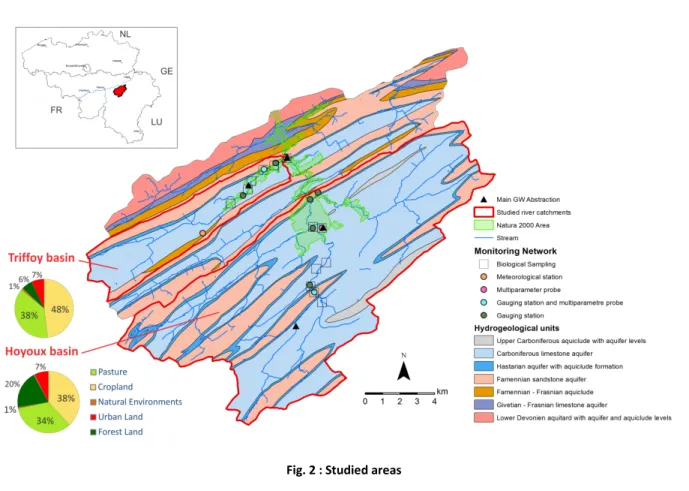Groundwater – surface water interaction in limestone areas of the GWB
BE_Meuse_RWM021 (Belgium)
Auteurs: Brouyère S., Briers P., Schmit F. , Orban P., Hallet V., Delloye F., Descy J.-P.
Case study produit par la Convention Région wallonne - HGE-ULg
Caractérisation complémentaire des masses d’eau dont le bon état dépend d’interactions
entre les eaux de surface et les eaux souterraines
Pour le Rapport Technique n°9 du Working Group Groundwater :
Hinsby, K., Schutten, J., Craig, M., Petitta, M. Prchalova; H. Technical Report on
Groundwater Associated Aquatic Ecosystems, European Commission, Directorate-General
for the Environment, Working Group Groundwater, Ed. T.Marschland and A. Foster
Wheeler, October 2015, 57p.
Citation recommandée:
Brouyère S., Briers P., Schmit F., Orban P., Hallet V., Delloye F., Descy J.-P. (2015),
Groundwater – surface water interaction in limestone areas of the GWB
BE_Meuse_RWM021 (Belgium), in: Technical Report on Groundwater Associated Aquatic
Ecosystems, European Commission, Directorate-General for the Environment, Working
Group Groundwater, Ed. T.Marschland and A. Foster Wheeler, October 2015, pp. 47-49.
Groundwater – surface water interaction in limestone areas of the GWB
BE_Meuse_RWM021 (Belgium)
Background information Type of case study
This case study is related to the ‘characterisation of water bodies whose status depends on
groundwater and surface water interactions’ project, led by hydrogeologists, freshwater ecologists
and agronomists for the Public service (Department of Water and Environment) of the Walloon Region of Belgium, under the WFD 2000/60/EC and the GWD 2006/118/EC.
In the Condroz region (central Wallonia), Carboniferous synclines aquifers are very important groundwater reservoirs facing significant quantity (groundwater abstraction) and quality (mainly nitrate from agriculture) pressures. Draining rivers host fragile GWAAE, such as biological travertines (Fig.1) and other freshwater ecosystems, particularly in the Hoyoux (MV07R) and Triffoy (MV08R) rivers. Detailed investigation (Fig.2) was performed during two years to characterize (1) GW – river interactions and their impact on GWAEE and (2) the transfer of nitrate in the soil – GW – river continuum.
Fig. 2 : Studied areas
Case Study description
Results show (Table 1) that the two rivers are characterized by very high base flow index (BFI=0,92-0,87), significant groundwater abstraction (IGWA=0,56-0,48) and typical alkaline signature (not shown). Nitrate concentrations are relatively constant throughout the year, close to the limit of good status (Fig.3). However, during the winter, nitrate concentrations increase temporarily and exceed the limit in rivers due to leaching of agricultural soil nitrate residue by infiltrating water.
Macroinvertebrates and benthic diatoms (Fig.4) were sampled at several sites to assess ecological status and structural and functional response to alteration of water quality (nutrient enrichment) and quantity (current velocity and stream habitats). Monitoring of pH and dissolved oxygen showed typical diel variations due to ecosystem metabolism, suggesting that natural ecosystem function has not been impaired in the studied streams. The analysis of the streams biological communities revealed a contrasting response of macro-invertebrates and benthic diatoms.
Biotic indices based on benthic macroinvertebrates confirmed the good ecological status except in one site. A detailed functional analysis of the macrobenthic assemblage at this site revealed a low taxonomic, biological and ecological diversity related to low current velocities allowing sedimentation and accumulation of particulate organic matter. Diatom indices and community structure indicated good to very good status in both studied streams, indicating that elevated nitrate concentration have no detectable effect on biological quality of the surface waters.
Fig. 3 : Nitrate dynamic in Hoyoux stream
Fig. 4 : Diatoms and macroinvertebrates
From September 2013 to August 2014 Hoyoux Triffoy
Climatic parameters
Annual precipitation P mm (%) 896,9 (100)
Evapotranspiration ETR mm (%) 612 (68)
Soil Available Water
Content variation SAWC mm (%) 67,2 (7,5)
EU = P – ETR - SAWC EU mm (%) 217,4 (24,5) Bassin parameters Surface S (km²) 145,2 30,5 Abstracted GW Qa mm (%) 163,4 (18) 117,9 (13) River flow Qt mm (%) 127,1 (14) 129,2 (14) Base flow Qb mm (%) 116,3 (13) 112 (12) Annual variation of Δres mm (%) -21 (-2) -12 (-1) GW reserves GW budget closure (including interbasin GW flow) ε mm (%) -51 (-6) -17,0 (-2) Infiltration (EU-(Qt-Qb)) I mm (%) 206,6 (23) 200,2 (22) Indicators
Base flow index (Qb/Qt) BFI 0,92 0,87
Infiltration index (I/EU) IESO 0,95 0,92
GW Abstraction index
Conclusions
These observations point to the need for considering the possible influence of groundwater abstraction for drinking water supply on stream hydromorphology in karstic watersheds, in addition to nutrient inputs to surface waters. The study also demonstrates that the analysis of the biological and ecological traits of benthic macroinvertebrates is an adequate tool for detecting the response of aquatic communities to alteration of stream flow resulting from groundwater and surface water interactions.
There is a need for data mining in existing databases to explore further the effects of nutrient enrichment (N vs. P) on biological indicators (diatoms in particular) as well as establishing relationships between hydrological variables on hydromorphological status in streams, in order to develop prediction models to assess the effects of reduced base flow on benthic assemblages (relevant to the e-flow). Specific conductance monitoring improved understanding of the system as it reflects mineralization of watershed and groundwater discharge to the stream and allowed more accurate hydrograph separation and base flow index computation.
From the perspective of improved knowledge, all strategical monitoring system (gauging stations with conductivity probes, frequent groundwater and surface water sampling) will be sustained for a mid and long term monitoring. Monitoring water quality at high temporal resolution in streams can be implemented if frequent sensor calibration is ensured: it is an adequate tool to assess ecosystem metabolism. However, nitrate concentration could be monitored once daily to study the influence of groundwater and other inputs from the catchment.
The presence of travertines in the studied streams raises a conservation issue, as these Natura 2000 biotopes are sensitive to eutrophication and to reduction of flow due to water abstraction. To some extent, this issue is related to the ecological flow (CIS guidance document nº31).
All results of the studies are available on the website of the project : http://goo.gl/5lLVGA or
http://www.facsa.ulg.ac.be/upload/docs/application/pdf/2015-10/characterisation_of_water_bodies_whose_status_depends_on_groundwater_and_surface_water _interactions.pdf

